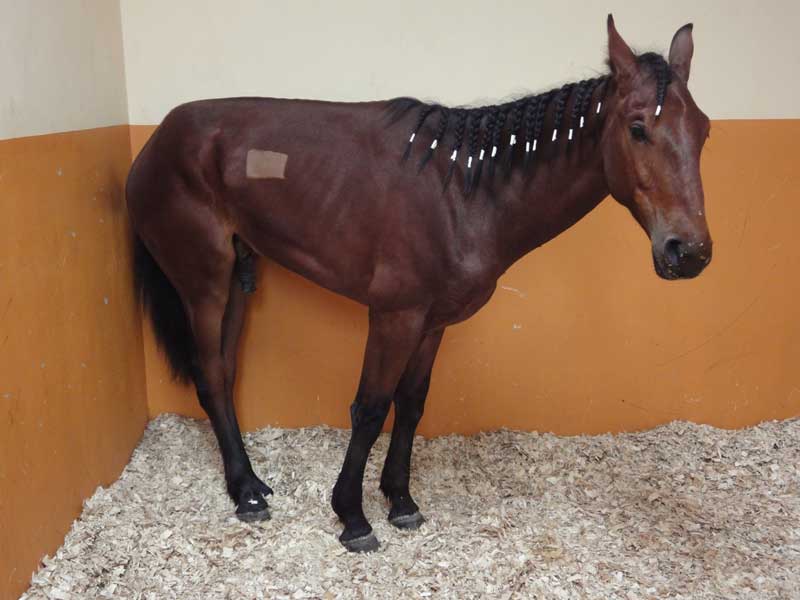Research sheds new light on Equine Grass Sickness

New research on equine grass sickness (EGS), published as a free special collection in the Equine Veterinary Journal (EVJ) this month (http://bit.ly/2dC7Drr), has improved our understanding of this devastating disease. Four separate studies are included, reporting novel risk factors for the disease, identifying key differences between EGS and botulism (questioning the hypothesis that EGS is caused by neurotoxins from Clostridium botulinum), reporting a novel diagnostic technique and showing the value of monitoring weight loss to help predict whether individual horses with chronic EGS are likely to survive.
Despite more than 100 years of research, supported predominantly by the The Moredun Foundation Equine Grass Sickness Fund (www.grasssickness.org.uk), the cause of EGS remains unknown. Since it almost exclusively affects grazing horses, a pasture derived neurotoxin is implicated. EGS causes gut paralysis as a result of damage to parts of the nervous system that control involuntary functions. Acute and sub-acute EGS is invariably fatal while around 55% of chronic cases can survive and return to a useful working life. The UK has the highest incidence of EGS in the world; indeed it is estimated that the disease kills between 1 and 2% of horses in the United Kingdom annually. Cases are more common in spring.
In terms of risk factors, the study ‘Equine grass sickness in Scotland: A case-control study of environmental geochemical risk factors’ suggests that the high incidence of the disease in Eastern Scotland may be partly associated with the particular composition of macro and trace elements in the soil in the fields on which horses graze. Further work is required to determine whether interventions to alter concentrations of particular elements in soil could potentially reduce the risk of EGS.1
A second study identified key differences between EGS and botulism, which questions the currently favoured hypothesis that EGS is caused by neurotoxins from Clostridium botulinum, a bacterium which commonly inhabits soil. The study ‘Equine grass sickness, but not botulism, causes autonomic and enteric neurodegeneration and increases soluble N-ethylmaleimide-sensitive factor attachment receptor protein expression within neuronal perikarya’ suggests that EGS is unlikely to be caused by neurotoxins from this bacterium and concludes that further investigation of an alternative cause for EGS is needed.2
While the majority of horses with EGS can be readily diagnosed by experienced veterinary surgeons, some cases present a diagnostic challenge. Indeed the only way to definitively diagnose the disease in a live horse is to demonstrate the characteristic degeneration of nerves within biopsies of the intestine. Unfortunately these biopsies can only be collected by performing abdominal surgery under general anaesthesia. In the study ‘Neuronal chromatolysis in the subgemmal plexus of gustatory papillae in horses with grass sickness’ characteristic degeneration of nerves was identified in small biopsies collected from tongues of EGS horses during post mortem examination. Examination of these biopsies accurately differentiated control horses from EGS cases. While further validation of this technique is required, it could potentially provide a relatively non-invasive method of confirming the diagnosis in a live horse.3
While around 55% of horses with chronic EGS survive, objective criteria for predicting survival of these cases are currently lacking. The study ‘Bodyweight change aids prediction of survival in chronic equine grass sickness’ reported that non-survivors had greater rate and magnitude of bodyweight loss than survivors. Survival prediction curves were published to allow veterinary surgeons and horse owners to use body weight data to help determine whether an individual horse with chronic EGS was likely to survive or die.4
Professor Bruce McGorum, Head of the Equine Section at the Royal (Dick) School of Veterinary Studies & Roslin Institute in Edinburgh, has been leading much of the research. He said: “Given that our recent research suggests that EGS is unlikely to be caused by neurotoxins from Clostridium botulinum we are now moving on to determine whether EGS is caused by ingestion of mycotoxins produced by pasture fungi. We are very pleased that The Horse Trust (www.horsetrust.org.uk) has provided funding for this three-year investigation.”
Professor Celia Marr, Editor of the Equine Veterinary Journal said: “While the cause of equine grass sickness continues to evade us, these papers present an optimistic step in the right direction for the eventual prevention of this dreadful disease. It is only with the support of the Moredun Foundation Equine Grass Sickness Fund and more recently that of The Horse Trust that our world-leading veterinary researchers are able to continue to unravel the mystery.”
The EVJ equine grass sickness collection can be downloaded at http://bit.ly/2dC7Drr
References
1Equine grass sickness in Scotland: A case-control study of environmental geochemical risk factors C. E. Wylie, D. J. Shaw, F. M. Fordyce, A. Lilly, R. S. Pirie, B. C. McGorum
2Equine grass sickness, but not botulism, causes autonomic and enteric neurodegeneration and increases soluble N-ethylmaleimide-sensitive factor attachment receptor protein expression within neuronal perikarya B. C. McGorum, S. Scholes, E. M. Milne, S. L. Eaton, T. M. Wishart, R. Poxton, S. Moss, U. Wernery, T. Davey, J. B. Harris, R. S. Pirie
3Neuronal chromatolysis in the subgemmal plexus of gustatory papillae in horses with grass sickness B. C. McGorum, R. S. Pirie, D. Shaw, N. Macintyre, A. Cox
4Bodyweight change aids prediction of survival in chronic equine grass sickness
Share this article with fellow horse lovers by using the share buttons below.
